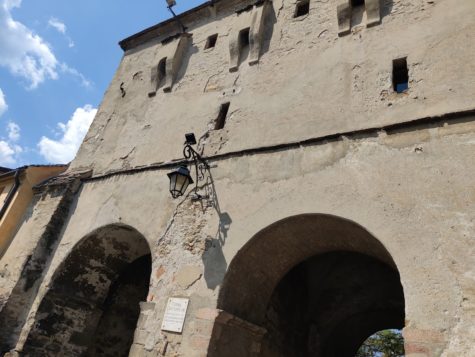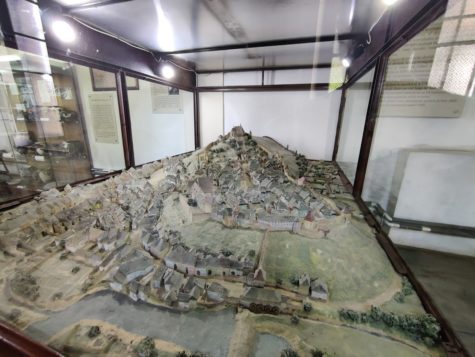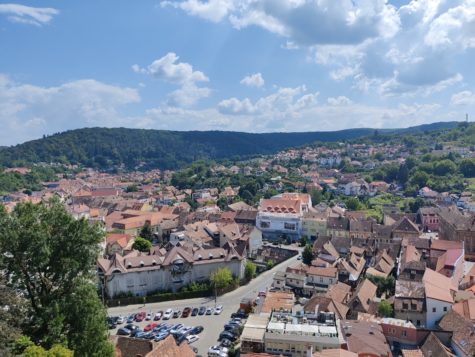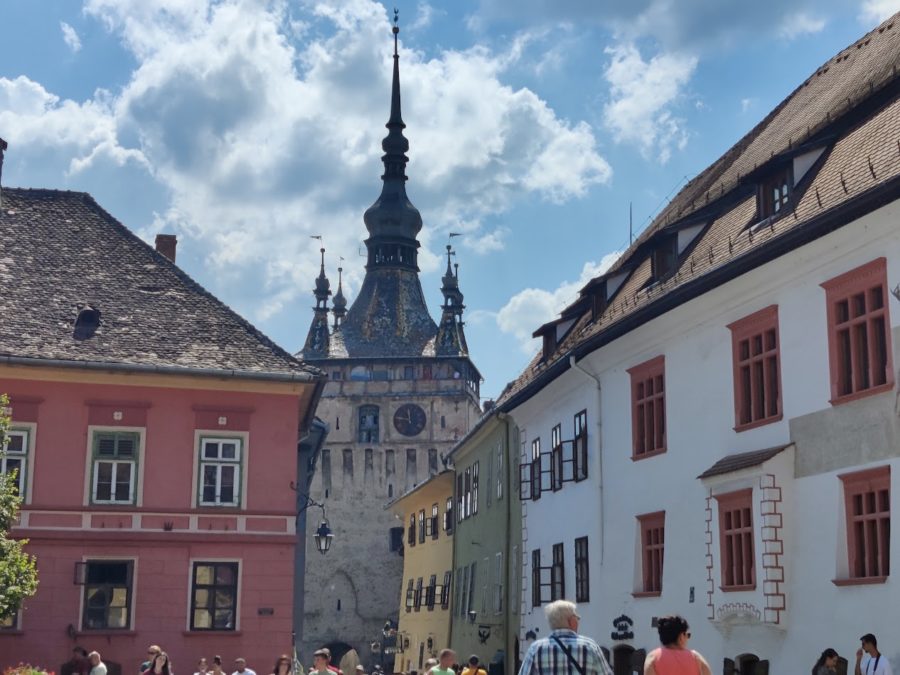Sighișoara: The Romanian Walled City
A look at one of Europe’s last inhabited medieval cities.
Standing tall in the historic center of Sighisoara Fortress is the Clock Tower, the master tower of the citadel, standing at 64 meters (209.974 feet) tall.
The city of Sighișoara is home to 26,370 Romanians, but the city’s history is held within the walls of the Sighișoara’s central citadel. Sighișoara is the last walled city in Europe where people live their daily lives and is a center of Romanian medieval history. The stone streets and traditional architecture are overseen by the watch towers surrounding the city walls. The city was deemed a United Nations Educational, Scientific and Cultural Organization (UNESCO) world heritage site in 1999 which has helped to preserve the city’s culture and history.
In order to understand the significance of Sighișoara we must take a step back to marvel at its rich history.
Sighișoara and its Saxon Roots
Sighișoara’s history goes back all the way to the 12th century. Sighișoara was founded by Saxon, a group of German settlers who migrated from the region of Franconia (now known as northern Bavaria) to central Transylvania. Many of these Saxons settled in modern-day Mures County and eventually would become known as the Transylvanian Saxons. They were sent from their home regions to come to defend the borders of the old Hungarian Kingdom. As defenders, the Saxons would build many citadels, defensive structures on high ground, in the region and by the 13th century they would build the Citadel of Sighisoara.
According to the old legend, the city was built in 1191, but its first recorded history was in 1280. Sighișoara would soon become an important city whose culture would only be rivaled by its strategic significance. The area developed into a hub for economic trade and cultural development in the region due to its location in between important European trade routes. This led to quick urban development despite frequent invasions and razing of historic moments by invading groups.
By the end of the 13th century, Sighișoara had developed into a bustling city inside and outside the citadel walls, developing its own culture and economic background as a trade city.
This economic culture would lead Sighișoara to be mostly filled by guild members; guilds became a new system of organizing labor in Europe. These guilds would create an economic culture in Sighișoara which would provide the city with stable sources of income and provide for those who were guild members. This in turn attracted more guilds to the city and by the 16th and 17th centuries, there were an estimated 15 guilds with more than 20 branches within Sighișoara.
This guild culture would lead the city to become a hub of economic development but also reflects the commercial nature of the city, with many stores and businesses popping up to provide goods and services to the city and those who passed through.
Sighișoara is a city of perseverance, rebuilding multiple times to survive plagues, invasions, and fires. This period of turmoil lasted from 1601-1676 but out of this emerged a beautiful story of triumph over their enemies and nature itself. The destruction of the Sighișoara was a blessing in disguise because it gave the city a lasting and defined sense of architecture due to the renovations of the destroyed buildings. As the city changed hands from different kingdoms and countries it continued to thrive as a medieval center in Transylvania. Now the city beauty stands out as one of most visited cities in Romania and is a popular tourist destination for Europe as a whole.
The Architecture of Sighișoara
Saxon culture has a big influence on the architecture of Sighișoara . The Saxon architecture left the city resembling many German cities of the same time period, leaving Sighișoara as the central city of the Transylvanian Saxons and preserving Saxon culture in the heart of Transylvania.
The Saxons would design the city to not only be architecturally pleasing but also to make it defensible to enemy attacks. Its prime location for business also made it a prime location for attacks and raids by invading groups, creating a civilian and military architecture to the city, which creates a mixed feeling about the city.
The architectural style of the city is mostly dominated by the Renaissance and Baroque styles. This adds to the mixed architectural stylings of the city and helps to elevate the beauty of Sighișoara. We see this architecture not only in the homes, but also in the walls of the citadel itself, and in some of the most famous landmarks within the city.

The Citadel is a sprawling defensive structure featuring a 930m long wall, 14 defense towers, and five artillery bastions. Nine towers, two bastions,and part of the enclosure wall are still preserved today.
The Clock Tower
The clock tower is one of the center points of the Sighișoara and is literally the center point of the city. It is what draws all eyes when someone enters the castle wall and is a defining monument not only of Sighișoara but of Transylvania as a whole. The tower is the citadel’s main tower which was designed to define the main gate to the citadel and is the highest point in the city. The tower stands at 64 meters high and was designed with the same architectural style as the whole citadel structure. The clock itself was made in Switzerland and added to the structure in 1648 and was motorized in 1964.
The citadel is a beautiful structure with a distinctly square shape to it, and it has a beautiful ornate roof with four small towers and one large tower at the center, which stands much higher than the rest with its distinct shape. It has an observation tower towards the top where you can observe the whole city. On the observation tower are small arrows that point towards other cities in Romania and most major cities in the world with the distance to the city. It is a very charming aspect that adds to the appeal of the tower. However, the view was the most stunning part with an observation of the city, looking upon the colorful houses and past the wall to see the whole city past the walls. Looking down at the people intermingling on the street, cars driving down to work, and kids biking around was certainly a sight to see.

Inside the Clock Tower can be found a museum that dates to 1898. To get into the museum, you need a ticket and will probably need to wait a bit so that the inside of the tower is not too crowded. With multiple floors and exhibits, there is so much to see inside the tower. The museum exhibits cover different artifacts from the history of Sighisoara, as well as cultural artifacts and educational information about some of the most important figures in the city’s history.
Biserica din Deal din Sighișoara
This is one of the most important churches in the region and lies on the outskirts of the castle walls. From the center of the citadel is a short hike to get to the church. Called Biserica din Deal din Sighișoara, which in English means Church of Sighișoara, it is an evangelical church created in 1488. Though Romania is a majority Orthodox country, this evangelical church is an important place of faith to Evangelicals in Romania and to the Saxon history which built Sighișoara.
The church itself is quite beautiful, housing a mural painting as old as the church itself. The mural, like many others within the Church, depicts holy scenes from the Bible and portraits of many saints and angels. These murals underwent a significant restoration effort in 1995 in order to preserve the artwork of the Church for future generations to come.
Most notably the Church is home to many historical events, one of which being the place where Gheorghe Rákóczi I was elected prince of Transylvania and King of Hungary in 1631. It also houses one of the largest organs in the area with 700 pipes, a keyboard of 4 octaves, 9 voices, and without a pedal. It was untouched until the first World War when its copper was used for the war but was replaced in 1928 with Zinc pipes.
The Chapel itself was rebuilt in the 12th century as a Romanesque-style basilica with a bell tower on the west side of the structure. After the Reformation, the church was used as the place of worship for Germanics living in Sighișoara. Many priceless artifacts from the 16th century are housed here and are now open to the public for viewing. As long as people remember that it is a holy place, they are welcome to come and tour the church’s murals, and sculptures, look at the artifacts, take a trip to the crypt below, or just gaze at the architectural beauty that is the Church. To this day, it stands as one of the city’s great architectural triumphs and is the pride of the city, since it can be seen from any height and angle in the city.
Casa Dracula
Casa Dracula may be one of the most important landmarks in the city of Sighișoara because of the infamy and legend surrounding Vlad Tepes: the man who inspired the story of Dracula. Vlad III was the King of Wallachia and his brutal tactics and rumors surrounding his rule would inspire Bram Stoker’s Dracula. His castle, Bran Castle, is one of the top tourist attractions in Romania, but not many people outside of Romania know that Vlad Tepes was actually born in Sighișoara.
Casa Dracula is the supposed birthplace of Vlad Tepes (Vlad III) and his residence until age four. It is the oldest civil structure in Sighișoara and was the place Vlad II waited to ascend to the throne. It is a place of historical importance due to the significance of Vlad the Impaler in Romanian history due to his struggles against the Ottomans for independence.
Located in the heart of the city, not too far from the clock tower, the house itself is an example of typical Romanian architecture, as it is a square river stone home painted yellow. The house has a plaque describing when Vlad lived in this house, describing him as the grandson of Mircea the Elder. Currently, the house is now a restaurant that uses the house’s history as part of its appeal. It is a medieval-styled restaurant decorated with historical artifacts and paintings of Vlad Tepes. It is advertised as quite an affordable restaurant serving both traditional Romanian cuisine and international dishes as well. As an additional experience, you can visit Vlad’s old room to experience part of the history of the town. Although the house is not in the same condition since Vlad’s birth, it is still a worthwhile stop during a trip to Sighișoara because of all the history surrounding the building — and a chance to get a nice meal, too.

Sighișoara is a beautiful city truly deserving of its UNESCO world heritage title. With so much history and culture still alive in the city today, it is a must-see city to experience Romanian history but also to experience one of the last vibrant citadels in Europe. From the architecture to the history and landmarks, Sighișoara and its culture are protected by the walled citadel which defines the city to this day.
The Clock Tower, The Church on the Hill, Casa Dracula, and all of its landmarks encapsulate both architectural and natural wonders, making it a destination that resonates with history buffs, culture enthusiasts, and nature lovers alike. It serves as a gateway to Transylvania’s captivating landscapes and its rich cultural heritage. Whether wandering through its medieval streets, exploring its historical sites, or simply savoring the tranquil atmosphere, Sighișoara leaves an indelible impression on all who visit.
Sighișoara is a city of perseverance, rebuilding multiple times to survive plagues, invasions, and fires. This period of turmoil lasted from 1601-1676 but out of this emerged a beautiful story of triumph over their enemies and nature itself. The destruction of the Sighișoara was a blessing in disguise because it gave the city a lasting and defined sense of architecture due to the renovations of the destroyed buildings. As the city changed hands from different kingdoms and countries it continued to thrive as a medieval center in Transylvania. Now the city beauty stands out as one of most visited cities in Romania and is a popular tourist destination for Europe as a whole.
Gabriel Marinescu is the Arts and Entertainment editor for ‘The Science Survey.' He enjoys the fact that journalism allows you to convey the facts in...

